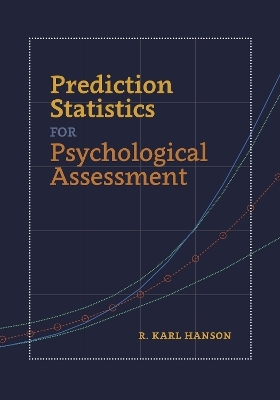
Prediction Statistics for Psychological Assessment
American Psychological Association (Verlag)
978-1-4338-3641-1 (ISBN)
At last, a comprehensive guide that meets psychologists and other social scientists' growing need to master the tools of statistical prediction.
Prediction Statistics for Psychological Assessment, by R. Karl Hanson, is the first book to teach students and practitioners the nuts and bolts of prediction statistics, while illustrating the utility of prediction and prediction tools in applied psychological practice.
This valuable resource uses real-world examples, helpful explanations and practice exercises to support the use of prediction tools in psychological assessment.
Actuarial risk assessment evaluators need to know how prediction tools work, how to evaluate them, and how to interpret their results in applied assessments.
Written in a clear and accessible manner, this user-friendly book helps readers understand how to evaluate and interpret different kinds of prediction tools, appreciate the numeric information used in risk communication, and utilize prediction tools to inform evidence-based decision making.
R. Karl Hanson, PhD is an adjunct research professor at Carleton University, Ottawa, Canada and formerly a researcher with Public Safety Canada from 1991-2017. His research concerns risk assessment and rehabilitation for individuals in the criminal justice and forensic mental health systems, with a particular focus on sexual offenders. He has a strong interest in the statistical methods used to quantify risk and to evaluate change over time. Follow @rkarlhanson and visit carleton.ca/psychology.
Preface
Part I: Background and Overview
Chapter 1: Introduction to Prediction Statistics in Psychology
Chapter 2: The Nature of Probability
Chapter 3: Overview of the Statistics Chapters
Part II: Statistics for Describing Likelihoods
Chapter 4: Proportions
Chapter 5: Discrete-Time Survival Analysis
Chapter 6: Kaplan-Meier Survival Analysis
Part III: Discrimination and Relative Risk
Chapter 7: Dichotomous Predictors
Chapter 8: Area Under the Curve
Chapter 9: Cohen's d
Chapter 10: Cox Regression
Chapter 11: Logistic Regression
Part IV: Calibration
Chapter 12: Chi-Square Goodness-of-Fit
Chapter 13: The E/O Index
Chapter 14: Meta-Analysis
Chapter 15: Calibration Plots
Part V: Percentile Ranks
Chapter 16: Percentiles
Part VI: Practice Considerations
Chapter 17: Estimating the Quality of Prediction Tools
Chapter 18: Standardizing Risk Communication
Chapter 19: Going Even Further
Appendix: Useful Algebra and Notation
Glossary
References
Index
About the Authors
| Erscheinungsdatum | 01.12.2021 |
|---|---|
| Verlagsort | Washington DC |
| Sprache | englisch |
| Maße | 178 x 254 mm |
| Themenwelt | Geisteswissenschaften ► Psychologie ► Klinische Psychologie |
| Geisteswissenschaften ► Psychologie ► Test in der Psychologie | |
| Sozialwissenschaften ► Soziologie ► Empirische Sozialforschung | |
| ISBN-10 | 1-4338-3641-6 / 1433836416 |
| ISBN-13 | 978-1-4338-3641-1 / 9781433836411 |
| Zustand | Neuware |
| Haben Sie eine Frage zum Produkt? |
aus dem Bereich


